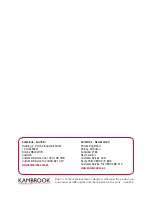
DTP HDMI 230 D Transmitter and Receiver • Installation and Operation
5
6.
Feed the twisted pair cables and, if applicable, the power cables through the opening
and through the wall box punch-out holes, securing them with cable clamps to provide
strain relief.
NOTES:
•
In order to fit in the wall box, the twisted pair cables and RJ-45 connectors
should not have a boot installed.
•
One power supply can power both the transmitter and the receiver, so only
one unit needs a power supply (see
Power Supply Wiring
on page 11 and
Ground Loops
on page 14.
7.
Trim back and insulate exposed cable shields with heat shrink to reduce the chance of
short circuits.
To prevent short circuits, the outer foil shield can be cut back to the point where the
cable exits the cable clamp.
8.
Connect the cables to the rear of the unit.
9.
Connect front panel devices (see
Connections
on page 6 for connector details),
restore the power supply, and test the transmitter and receiver system. Make any
cabling adjustments before final installation, as the cables will be inaccessible
afterwards.
Mud ring installation
1.
Using the mud ring as a guide, mark the edges and cut out the material within the
marked area.
2.
Insert the mud ring into the opening, rotate and secure the locking arms with the
supplied screws shown in figure 3.
3.
Follow steps 6 through 9 of
Site preparation and wall box installation
above, and
Final installation
on the next page.
Mud Ring
Wall
Figure 3.
Installing the Mud Ring








































